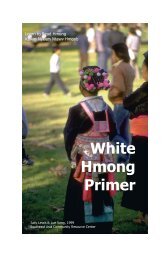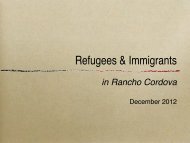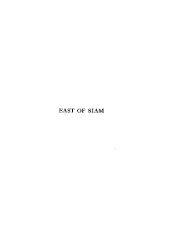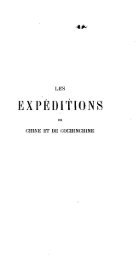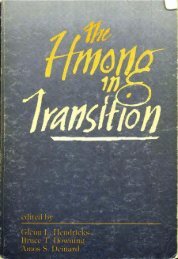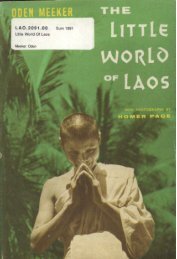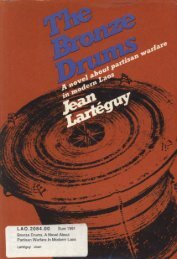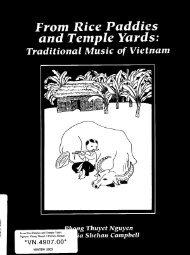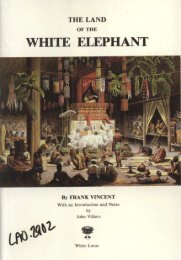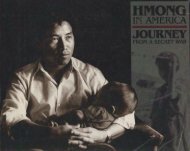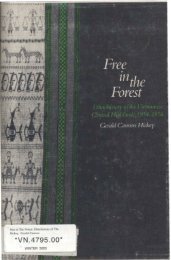PEOPLE
Grant, The Boat People - Refugee Educators' Network
Grant, The Boat People - Refugee Educators' Network
- No tags were found...
Create successful ePaper yourself
Turn your PDF publications into a flip-book with our unique Google optimized e-Paper software.
73s Boat People<br />
refugee problem was tough-minded. It consistently turned away<br />
boat people from Vietnam unless they were guaranteed rapid<br />
resettlanent, an the grounds that Singapore was overcrowded<br />
already and would become a magnet for refugem if it relaxed its ban.<br />
'You've got to grow callouses on your heart m you just bled to<br />
death,' Prime Minister Lee Kuan Yew said. In a speech on 17 February<br />
1979, he foreign minister, Sinnathamby Rajaram, put forwud<br />
an argument which other MEAN governments were to take<br />
increasingly seriously as the year advanced and the numbers of boat<br />
people arriving in South-East Asian waters reached torrential proportions:<br />
The flow of boat people pea the nonammunist world, including the<br />
cwneies, with s moral dilemma. We could respond on humnimrian and<br />
mml grounds by a cceg and resettling thew dcsperare people. But by<br />
doing sr, we would not only be encouraging thw responsible to force even<br />
more refugees to Ase but elno unwittingly demonsmtc that a policy of inhumanity<br />
[the Vicmmesc government's] doel p y divided. Not only that, but<br />
lose countries which give way m their humanitarian instincm would saddle<br />
themrlves with unmanageable poPticPI, mill and economic probiems that<br />
the sudden sbmrption of hundreds of hands of alim pcoplcs must inevimbly<br />
bring in its wake.<br />
While suspecting China's long-term intentions towards South-<br />
East Asia, Singapore was equally wary of Vietnam and Russia.<br />
Singapore wanted ASBAN to give Thailand assurances of support in<br />
the face of the Ind+Chim crisis; otherwise, it feared, Thailand<br />
might kcomc excessively dependent on China. Singapore also<br />
wanted ASEAN to speak out and put pressure on Vitmam to change<br />
its policies so that people would not feel impel14 to leave by the<br />
backdoor sea route. In his New Year message for 1979, Prime Minister<br />
kt called for an international campaign to prevent the exodus.<br />
h t suffering in Indo-China had ken the result of acts committed<br />
in the heat of war:<br />
This latest d u s of 'boot pcopk' and 'ship people' is the result of aco of<br />
cold calculation, measured in gold, and long after rhc heat of battie has<br />
cooled. What is ominous is hat unless world leaders and leader-writers register<br />
their outrage st his cynical digposal of unw~ntcd citizens, many more<br />
victims will be sent off on packed hats and ships,<br />
The ASBAN country most seriously affected by the deluge of boat<br />
people from Viemm was Malaysia. UntiI law 1978, refugees wanting<br />
to land thm pending resettlement ovmeas could usually do so<br />
without too much difficulty, Malaysian fishermen and villagers<br />
often helped the newcornem, sometimes for a fee but also from spontancws<br />
compassion. However, the tidal-wave dimensions of the<br />
refugee inflow changed Malaysia's md. The influx generated<br />
undercurrents of politiaal and communal tension in Malaysia. In<br />
1969 the country's multi-racial, multi-religious fabric had been<br />
stitched together again with care after the delicate balance between<br />
Chinese of immigrant st&<br />
and indigenous Malays had been shat-<br />
tered by race riots in Kuala Lurnpur. The population was now about<br />
14 million, the ove~rhelming majority living in peninsular Malaysia<br />
(as distinct from the eastern states of Sabah and Smrawak) where<br />
Muslim Malays (53 per cent) barely ournumber non-Muslim races<br />
- mainly the Chinese (35 per cent) and Indians (1 1 per cent) - the<br />
forebears of whom had arrived to work in mines, plantations and<br />
towns ovet the past 150 years. As in other parts of &uth-EPS~ Asia,<br />
the Chinese beaame influential in the country's commerce, trade and<br />
finance. This caused resentment from Malays whose tr~dilionrl<br />
vccuptions were farming and fishing.<br />
The refugees from Vietnam, more than half of whom were of<br />
Chine* descent, could hardly have chosen a more sensitive place<br />
to land than the nonh-east coast of peninsular Malaysia, The three<br />
states there - Kelantan, Trengganu and Pahang - which face the<br />
Gulf of Thailand and the South China Sea, are all overwhelmingly<br />
,Malay in composition and strictly isl~mic in character. Malaysia<br />
(whose state religion is Islam) had accepted more than 1500 Muslim<br />
refugees from Kampuchea after 1975, and allowed an estimated<br />
100000 Filipino Muslims emping civil war in the southern Philippines<br />
to take refuge in the cast Malaysian state of Sabah, But the<br />
flood of so many non-Muslim aliens from Vietnam created a backlash<br />
in constnative Malay communities along the north-eaat coast.<br />
Ry late 1978 some Malay villagers were stoning incoming boats and<br />
the men, women and children on them. There were rumours in the<br />
kanrpon~s (villages) that MnIaysia would never be able to get rid of<br />
the refugees. Thc government was accused of allowing a form of<br />
backdoor immigration (it had encouraged this kind of alarmism by




